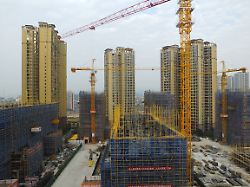economy is trapped
China’s fat years are over
By Max Borowski
01/18/2023, 5:50 p.m
The Chinese economy is growing at its slowest pace in decades. This is less an expression of a crisis than of a new normality. Gone are the days when the communist leadership could “conjure up” growth almost at will.
Months of lockdowns that paralyzed entire metropolises, a deadly corona wave at the end of the year, a bursting real estate bubble, rising commodity and energy prices and falling export demand as a result of the global downturn: Given the huge shocks to China’s economy over the past year, it is unsurprising that the 5.5 percent GDP growth target set by the communist leadership was missed by a wide margin. After all, according to official figures, despite all the crises, economic output increased by three percent. At first glance, this figure may give cause for hope: If such a development is possible even in the acute crisis situation, doesn’t the Chinese economy then have the best chance of returning to the old pace of growth as soon as the shocks pass?
On closer inspection, that seems unlikely. The pace of growth over the past year, the slowest in around three decades, is less an expression of an acute crisis than of a new normal. “The good years are definitely over,” says an analysis of the prospects for China’s economy by the German foreign trade agency GTAI. In the future, too, the GDP will only grow by two to three percent per year “without a corona test special boom and embellished calculation”.
The past year has shown where the sore spots in the Chinese economy lie, says Max Zenglein, chief economist at the Mercator Institute for China Studies. On the one hand there is the bloated real estate sector, which accounts for around a quarter of the entire Chinese economy. Several large and many small companies have collapsed under the industry’s enormous debt burden. Home sales and prices plummeted. This has left millions of middle-class homeowners poorer on paper. This in turn contributed to their reluctance to consume.
“You can’t send unemployed university graduates to construction sites.”
Job and loss of income in the course of the corona lockdowns did the rest to weaken domestic demand. At the same time, demand from abroad for the products of China’s key export industry dropped noticeably. What became apparent is that the Chinese government has lost its ability to steer the economy and, as Zenglein explains, to “conjure up growth” even in crises. For example, China successfully fought the global economic crisis of 2008 with gigantic spending programs, especially for infrastructure. But today, comparable initiatives are largely fizzled out. “China’s economy has evolved and changed structurally,” explains Zenglein. “You can’t send unemployed university graduates to construction sites.”
Beijing has also decided to pay more attention to quality than quantity when it comes to economic development. This means, among other things, that less growth should be financed on credit. This is more sustainable than, for example, the apparent prosperity that the real estate sector has inflated for decades with enormous debt. But in practice, such a resolution limits the possibilities of stabilizing the collapsed housing market, for example.
The crisis has also shown that not much has happened with regard to the long-declared goal of expanding domestic consumption as a pillar of the economy in comparison to the export industry and the real estate market. “On the contrary, in this respect the past year was a setback,” said Zenglein. This is also due to the fact that the communist leadership would have to relinquish some of its control over economic development if consumption played a greater role. “Compared to industry and the infrastructure sector, consumption is based more on the autonomous decisions of individual consumers and can therefore be controlled less politically. The KP has a hard time with that.”
Simply being satisfied with the much weaker growth that is to be expected is probably not an option for China’s leadership under President Xi Jinping. After China managed to double GDP per capita between 2010 and 2020 according to plan, the official goal is to double economic power again by 2035. This requires calculated annual growth rates of almost five percent.
Achieving this seems extraordinarily difficult, says Zenglein. China remains at risk of falling into the “middle-income trap”. This phenomenon, in which an initially rapid process of catching up with the industrialized countries suddenly comes to a standstill, can also be observed in other developing countries. “But it hits China particularly early,” said Zenglein. There is currently a similar development in South Korea. But per capita GDP there is three times higher than in China.
